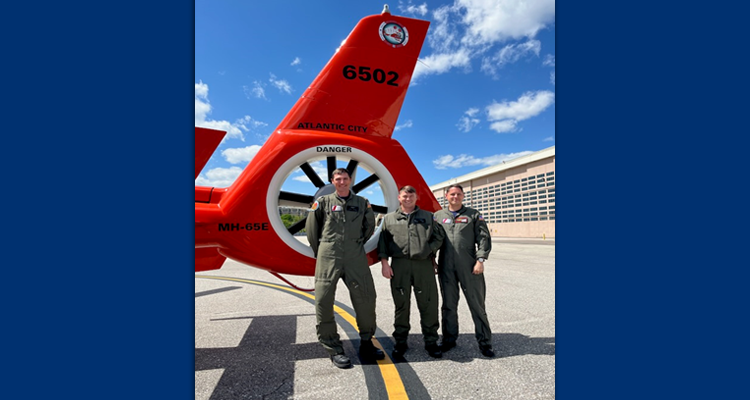May 10, 2023 —

The crew that stood the first watch with an upgraded MH-65E at the National Capital Region Air Defense Facility checks out “Blackjack 2” (CGNR 6502). From left: Lt. John Sapundjieff, Petty Officer 2nd Class Eli Gessner and Lt. Cmdr. Brian Ward. U.S. Coast Guard photo.
The National Capital Region Air Defense (NCRAD) Facility stood watch with the upgraded MH-65E Dolphin short range recovery helicopter for the first time on April 17. The NCRAD facility Rotary Wing Air Intercept (RWAI) mission falls under Air Station Atlantic City, New Jersey, with two aircraft dedicated to the Washington, D.C., area.
Crew members had nothing but praise for the enhanced capabilities of the Echo model, such as the new Common Avionics Architecture System that manages critical mechanical functions like preventing engine over-torque. The superimposed power limitations use all available power to maximize aircraft performance while limiting potential damage to mechanical systems during maneuvers. This improved flight director automation increases situational awareness and allows for better control during maneuvers.
“I most appreciate the way the flight director is now capable of true four-axis flight, allowing aircrews to focus more attention on mission execution,” said Lt. Cmdr. Brian Ward, aircraft commander of the first crew to assume duty on the Echo model, using “Blackjack 1” (CGNR 6604).
While the mechanical airframe is much the same as the MH-65D, the avionics and interfaces are completely new. Crewmembers who fly the NCRAD mission invested significant time in the memorization of both the in-flight checklist and new RWAI intercept procedures with the updated aircraft, ensuring expedient compliance and a smooth, practiced execution of necessary steps should the aircraft be launched.
The MH-65 Conversion and Sustainment Program regularly receives feedback from the operational fleet on how the capabilities of the upgraded Echo allow the crew to continually be safer and more efficient when executing the mission. Ward said he is confident that the upgrades provided by the MH-65E will serve RWAI crews well.
“The engineer in me loves the way performance planning is integrated into the flight plan,” he said. “The fact that I can view the helicopter’s performance parameters, to include weight and balance calculations, at every step along the flight plan is incredible.”
For more information: MH-65 Short Range Recovery Helicopter Program page